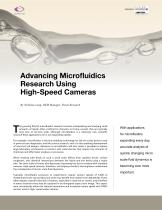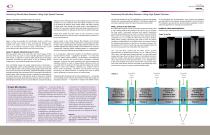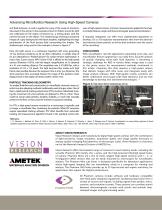 Website:
Vision Research
Website:
Vision Research
Group: AMETEK
Catalog excerpts

Advancing Microfluidics Research Using High-Speed Cameras By Nicholas Long, OEM Manager, Vision Research he growing field of microfluidics research involves manipulating and studying small amounts of liquid, often confined to channels (or living vessels) that are typically only tens of microns wide. Although microfluidics is a relatively new scientific research field, applications for it are expanding rapidly. With applications For example, microfluidics is the key enabling technology for lab-on-a-chip devices used in point-of-care diagnostics and life science research, and it is also enabling development of new fuel cell designs. Advances in microfluidics will also make it possible to replace large laboratory instruments or reactors with small devices that require tiny amounts of chemicals and offer faster analyses or processes. When working with fluids on such a small scale, effects from capillary forces, surface roughness, and chemical interactions between the liquid and the device play a major role. The time-scale of events also decreases, becoming too fast to analyze with standard cameras. High-speed cameras, therefore, are helping scientists and engineers understand the complexities of micros-scale fluid dynamics. Typically, microfluidic processes or experiments require camera speeds of 3,000 to 25,000 frames-per-second (fps), but some may benefit from speeds over 200,000 fps. Flows often display a specific direction of motion, especially in channels or vessels, and therefore in many situations they may be captured in an elongated aspect ratio image. This aspect ratio conveniently allows for reduced resolutions and increased camera speed with CMOS sensors used in high- speed video cameras. accurate analysis of quickly changing micro scale fluid dynamics is becoming ever more important.
Open the catalog to page 1
Advancing Microfluidics Research Using High-Speed CamerasAdvancing Microfluidics Research Using High-Speed Cameras Figure 1 shows an example of a microfluidics study, in which two different fluids were mixed and the resulting tiny droplets were studied. The image is from a sequence captured at 10,000 fps with a 20 microsecond exposure, using a Phantom Miro LC310 monochrome high-speed camera and Leica microscope. QUALITY IMAGES PROVIDE QUALITY DATA Most researchers want to do more than just record images of fluid dynamics; they also want to extract valuable quantitative data from their...
Open the catalog to page 2
and fluid behavior, as well as applied to many of the research situations discussed in this article. In the examples shown in Videos 3a and 3b, light was collimated on the region of interest (i.e., a resting drop), with the camera focused on the object. This shadowscopy technique produced images of a grey background with black droplets, highlighting the large perturbation of the fluid density field surrounding the droplet. The shadowscopic setup used in this example is shown in Figure 4.1 Here, the light source is a continuous Superlum LED array generating 104 lux luminous incidence at 40...
Open the catalog to page 3All Vision Research catalogs and technical brochures
-
PHANTOM S711
4 Pages
-
PHANTOM S641
4 Pages
-
PHANTOM Miro® C321 Airborne
4 Pages
-
PHANTOM TE2010
4 Pages
-
PHANTOM T4040 T2540
4 Pages
-
PHANTOM S991
4 Pages
-
Miro C
4 Pages
-
VEO-SERIES
4 Pages
-
TMX-SERIES
4 Pages
-
Phantom S640
2 Pages
-
Phantom VEO 1310
2 Pages
-
CineMag V and CineStation
2 Pages
-
N5
2 Pages
-
S200
2 Pages
-
v2512
4 Pages
-
v2640 ONYX
4 Pages
-
Workflow Whitepaper
4 Pages
-
Schlieren Whitepaper
4 Pages
-
Explosives Whitepaper
6 Pages
-
DIC Whitepaper
3 Pages
-
Phantom® Flex4K-GS
4 Pages
-
Phantom® VEO
6 Pages
-
Phantom® VE04K
4 Pages
-
Phantom® VEO4K-PL
4 Pages
-
Flex4K
4 Pages
Archived catalogs
-
PHANTOM T1340
4 Pages
-
Phantom® v1840 / v2640
4 Pages
-
v2640
4 Pages






























